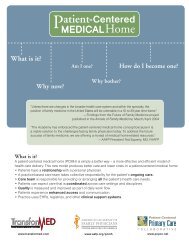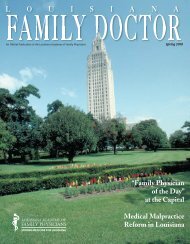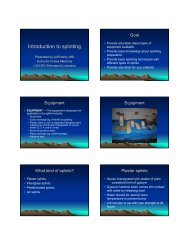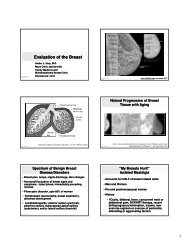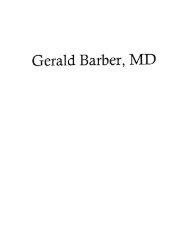New Drug Update 2009-2010 - LAFP
New Drug Update 2009-2010 - LAFP
New Drug Update 2009-2010 - LAFP
Create successful ePaper yourself
Turn your PDF publications into a flip-book with our unique Google optimized e-Paper software.
primary route of elimination.<br />
Table 2. Comparison of the Pharmacokinetic Parameters for Duloxetine and Milnacipran<br />
Parameter Duloxetine Milnacipran<br />
T max<br />
a<br />
6 h 2 to 4 h<br />
Bioavailability — 85% to 90%<br />
Protein binding > 90% < 13%<br />
Half-life 12 h 6 to 8 h<br />
Elimination primary route Hepatic (CYP1A2, CYP2D6) Renal (55% as unchanged drug in the urine)<br />
a T max = time to maximal plasma concentration.<br />
COMPARATIVE EFFICACY:<br />
Fibromyalgia<br />
Milnacipran was assessed in a randomized, double-blind, placebo-controlled study enrolling 1,196<br />
patients meeting the American College of Rheumatology criteria for fibromyalgia. The majority of patients<br />
were women (96.2%) and white (93.5%), with a mean age of 50.2 years. Patients received milnacipran<br />
100 mg/day (399 patients), milnacipran 200 mg/day (396 patients), or placebo (401 patients) for 15<br />
weeks. Patients were required to discontinue all centrally acting fibromyalgia therapies, including<br />
antidepressants, sedative-hypnotics, anticonvulsants, muscle relaxants, and centrally acting analgesics,<br />
as well as transcutaneous electrical nerve stimulation, biofeedback, tender and trigger point injections,<br />
acupuncture, and anesthetic or narcotic patches. Limited rescue doses of hydrocodone were permitted.<br />
The primary efficacy end point for the “treatment of fibromyalgia” was a composite defining responders as<br />
patients with at least 30% pain improvement as assessed by the change from baseline in 24-hour<br />
morning recall pain collected from daily e-diary scores, a rating of “very much improved” or “much<br />
improved” on the Patient Global Impression of Change (PGIC), and an at least 6-point improvement from<br />
baseline in physical function (SF-36 Physical Component Summary score). The primary end point<br />
measure for “treatment of pain of fibromyalgia” was a composite defining responders as patients<br />
achieving at least 30% improvement in pain in 24-hour morning recall pain and rating themselves as “very<br />
much improved” or “much improved” on the PGIC scale. Results were analyzed using baseline<br />
observation carried forward (BOCF), for which any patients missing any primary end point data were<br />
classified as nonresponders, as well as a last observation carried forward (LOCF) and a completer<br />
analysis. Odds ratios for response compared with placebo are summarized in Table 3. At 15 weeks, there<br />
were more “treatment of fibromyalgia” responders in the milnacipran groups than in the placebo group<br />
(15% [P = 0.011] and 14% [P = 0.015] for 100 and 200 mg/day groups, respectively vs 9% for placebo).<br />
Response rates for “treatment of pain of fibromyalgia” were also greater in the milnacipran groups (23%<br />
[P = 0.0252] and 25% [P = 0.0037] for 100 and 200 mg/day groups, respectively, compared with 16% for<br />
placebo). Pain improvements were reported to be evident as early as 1 week after initiation of<br />
milnacipran. At 3 months, milnacipran was also reported to be associated with improvements in additional<br />
pain measures (morning recall pain, weekly recall pain, real-time pain, paper visual analog scale [VAS]<br />
measures), as well as the PGIC (both doses, P < 0.001). Discontinuation rates were 28% in the placebo<br />
group, 34% in the milnacipran 100 mg/day group, and 35% in the milnacipran 200 mg/day group (Clin<br />
Ther. 2008;30(11):1988-2004).<br />
Table 3. Odds Ratios for Composite Response in Adults With Fibromyalgia Treated for 15 Weeks<br />
With Placebo or Milnacipran<br />
Parameter Milnacipran 100 mg/day Milnacipran 200 mg/day<br />
Fibromyalgia treatment<br />
BOCF 1.79 (95% CI, 1.14 to 2.8) a,b 1.75 (95% CI, 1.11 to 2.75) b<br />
LOCF 1.82 (95% CI, 1.18 to 2.78) c 1.9 (95% CI, 1.24 to 2.91) c<br />
60




